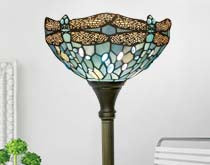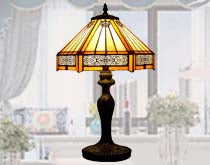What Are the Light Bulb Types?
When we consider buying lighting fixtures for a specific space, bulbs can create the ideal light for our home and office environment. Choosing the right lighting fixture, such as Tiffany table lamps or Tiffany floor lamps, not only adds to the beauty of the space but also perfectly matches different types of bulbs, improving energy efficiency and lifespan.
This article will explore several common types of bulbs, including how they work and their pros and cons, to help you make a smarter lighting choice. In this way, you can have the best light solution, whether it is to enhance the atmosphere of your home or optimize your office environment.
What is a light bulb?

A light bulb, also known as an electric bulb or light source, is a device that produces light, usually by exciting the luminescent material inside through an electric current. It mainly consists of a closed glass shell and an internal light-emitting mechanism, which can be a filament, gas, or other electric light source. The basic function of a light bulb is to convert electrical energy into light energy.
It is widely used in home, commercial, and industrial environments to provide necessary lighting and enhance the beauty of the space. Modern light bulb design focuses on energy efficiency, lifespan, and environmental impact, including various types such as incandescent lamps, halogen lamps, fluorescent lamps, and LED lamps.
Related knowledge: What is Tiffany Table Lamp
What are the light bulb types?

1. Incandescent lamp
An incandescent lamp is a traditional electric lamp that uses an electric current to heat a tungsten filament sealed in a glass shell, causing it to reach a high temperature and emit light.
The light color emitted by this bulb is gentle and warm, which is very suitable for creating a comfortable atmosphere in the home. Incandescent lamps are simple in design and widely used, from home lighting to industrial applications.
Advantages
-
Low cost: Incandescent lamps are cheap to produce and can be purchased at a very economical price.
-
Instant lighting: No warm-up time is required, and the switch lights up immediately.
-
Warm color temperature: The light emitted is soft and the color temperature is warm, which is suitable for home environments.
-
Good color rendering: High color reproduction and accurate presentation of object colors.
Disadvantages
-
Low energy efficiency: Only 5% of electrical energy is converted into light energy, and the remaining 95% is converted into heat energy.
-
Short life: Compared with other types of bulbs, incandescent lamps have a shorter service life, usually between 750 and 2000 hours.
-
High heat generation: A lot of heat is generated during operation, which may affect the indoor temperature.
2. Halogen lamp
The halogen lamp is an improved version of an incandescent lamp, which has halogen gas added inside. When this kind of bulb is working, the gas recombines with the evaporated tungsten, which prolongs the life of the filament and improves the light effect.
Halogen lamps provide brighter light and higher color temperature, which is very suitable for occasions that require strong direct light.
Advantages
-
Higher light effect: 15% to 30% brighter than ordinary incandescent lamps.
-
High color temperature: can reach 3000K to 4000K, which is closer to natural light.
-
Longer life: Halogen lamps have a longer life than traditional incandescent lamps, about 2000 to 4000 hours.
Disadvantages
-
High heat generation: It generates higher heat during use.
-
Higher cost: Halogen lamps are more expensive than ordinary incandescent lamps.
-
Safety risks: High temperatures may cause safety hazards.
3. Fluorescent lamp
The fluorescent lamp is a kind of light bulb that uses electric current to excite low-pressure mercury vapor to produce ultraviolet light, which then excites phosphor to emit visible light. Such bulbs are widely used in commercial and educational environments because they provide more uniform light and higher efficiency.
Advantages
-
High energy efficiency: Fluorescent lamps are much more energy efficient, saving about 70% more energy than incandescent lamps.
-
Long life: Life is usually more than 8,000 hours, much longer than incandescent lamps.
-
Even light: Suitable for office and learning environments.
Disadvantages
-
Contains mercury: Environmental recycling and disposal are more complicated.
-
Turn-on delay: A short warm-up time is required.
-
Flicker problem: This may cause eye fatigue or headaches.
4. LED lamps (light-emitting diodes)
LED lamps use solid-state semiconductor materials to provide lighting by directly converting electric current into light. LED lamps are becoming increasingly popular due to their excellent energy efficiency and long life, and are suitable for a wide range of applications from home lighting to street lighting.
Advantages
-
Extremely high energy efficiency: More than 80% energy saving than incandescent lamps.
-
Long life: Can reach 25,000 to 50,000 hours.
-
Environmentally friendly: Contains no harmful substances and is easy to recycle.
Disadvantages
-
High initial cost: Although the total cost is low, the initial purchase cost is high.
-
Light quality issues: Low-quality LED products may have problems such as inconsistent light color and light decay.
5. Compact fluorescent lamp (CFL)
A compact fluorescent lamp is a miniaturized form of fluorescent lamp technology, usually in a spiral or folded shape. This type of bulb is popular with home users because of its much higher energy efficiency and longer life than incandescent lamps.
Advantages
-
Energy saving: about 75% more energy saving than incandescent lamps.
-
Longer life: The service life is several times that of incandescent lamps, about 8,000 to 15,000 hours.
-
Many color temperature options: color temperatures ranging from 2700K to 6500K are available.
Disadvantages
-
Contains mercury: Although the content is small, it requires special handling.
-
Delayed start: It takes time to warm up after turning on to reach maximum brightness.
-
Higher cost than incandescent lamps: The initial investment is larger.
Tips for buying light bulbs
-
Determine the purpose: Choose the right type based on the specific purpose of the bulb, such as reading, mood lighting, or outdoor use.
-
Choose the type of light source: LED lights are suitable for most home uses, energy-saving, and long-lasting; incandescent or halogen lights are suitable for occasions where instant brightness and warm light are needed.
-
Consider brightness (lumens): Choose the right number of lumens based on the required brightness, and kitchens and bathrooms may require brighter bulbs.
-
Choose color temperature: Bulbs with low color temperatures (2700K-3000K) emit warm yellow light and are suitable for home; bulbs with high color temperatures (3500K-5000K and above) emit white or blue light and are suitable for office and functional lighting.
-
Check energy efficiency labels: Choose bulbs with high energy efficiency ratings, which may cost more initially but save electricity bills in the long run.
-
Confirm dimming compatibility: If using a dimmer, make sure the bulb supports dimming.
-
Understand life expectancy: Choosing bulbs with a long life can reduce the frequency of replacement and save costs.
-
Consider environmental factors: Choose environmentally friendly bulbs, such as LEDs, which are easy to recycle and do not contain harmful substances.
How to choose the right lampshade for your light bulb?

When choosing the right lampshade, it is important to consider the material, size, and how it will coordinate with the room's decor. For example, a Tiffany lampshade, known for its colored glass and fine craftsmanship, is perfect for vintage or art-style interiors. This lampshade not only provides a beautiful light effect but also serves as a decorative artwork to add to the room's visual appeal.
Also, consider its effect on light. Lampshades of different materials and colors will change the distribution and intensity of light. For example, a dark or heavy material will produce a soft light effect, while a clear or light-colored lampshade will let more light penetrate and is suitable for spaces that require bright light.
With these considerations, you can choose the most suitable lampshade for each room, which not only meets the lighting needs but also perfectly integrates into the overall decor style.
Summary
As we explore different types of light bulbs, we learn that each has its own unique functions and applicable environments. From traditional incandescent lamps to efficient LED lamps, choosing the right bulb is not only about light quality but also about energy efficiency and lifespan. As we consider the type of bulb, don't ignore the importance of choosing the right lampshade for the overall lighting effect.
Tiffany lampshades, with their unique colored glass and exquisite design, can not only add an artistic sense to interior decoration but also perfectly match various bulb types, enhancing the beauty and practicality of the light. Therefore, whether in the home or commercial space, a reasonable combination of bulb type and lampshade design can significantly improve the light environment and aesthetic value of the space.
Related reading: Why do LED lights flicker

























